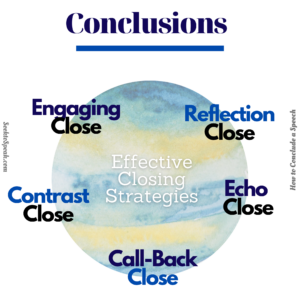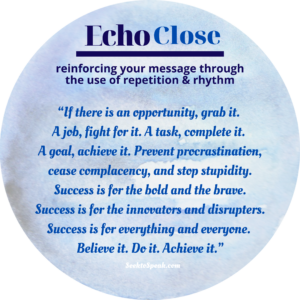This article will discuss five easy and effective closing strategies that will creatively conclude your speech, reinforce your message, and leave the audience wanting more!
As discussed in Part 1 of the Epic Ending Series, the audience is most likely going to remember the last thing you say. Therefore, your conclusion must be an impactful one. The best conclusions can change perspectives, habits, and even lifestyles.
Below are several effective ways to end your speech through the use of creative closings.

Engaging Close
Engaging Close is a strategy that engages the audience by inviting, calling, or challenging them into action. You can do this by asking, urging, or challenging your listeners to join a charity, to fight for a change, or dump a bad habit. It is effective as your audience will feel committed to a change. It is widely known that if you can convince your audience into action, your message will be further reinforced and spread.
For example, this is a conclusion on the topic, “Mother Earth“:
“The time is now for us to change our choices and actions which hurt our earth. No longer can we ignore the winds of change that cause heat waves in some countries and natural disasters in others. We must all work together and be the change we want to see in the world. Join me in this fight against climate change by going green, practicing a zero-waste policy and of course, to always reuse, reduce and recycle.”
Note: This is an Engaging Close as it is demanding that the audience practice a more eco-friendly lifestyle. It does not just seek to inform the audience of climate change but goes further to request that the audience personally do something about it.

Reflection Close
A Reflection Close is a strategy that encourages reflection and thought. It attempts to make the speaker’s message more relatable or thought-provoking by using a mix of emotions and logic. A Reflection Close usually contains a memorable quote, surprising evidence, or an emotional anecdote – often used to change mindsets and perspectives.
For example, on the topic, “Speaking in Public“:
“With proper practice and preparation, there is nothing to fear when speaking in public. Everybody has a voice that wants to be heard and opinions that matter to the world. I will tell you now, what Christopher Robin told Winnie the Pooh to find courage, ‘Promise me you’ll always remember: You’re braver than you believe, stronger than you seem, and smarter than you think.’”
Note: This is a Reflection Close because it ends the speech with a memorable quote for the audience to ponder and think about. When using a quote, always remember to select quotes that are easy to remember, repeat, and follow.

Contrast Close
A Contrast Close creates interest by completely changing your delivery style or content of a speech. This can be done by unexpectedly switching the tone or substance of your speech. This strategy generates appeal as it catches the audience off-guard, making them pay attention and recall your conclusion better.
For example, on the topic, “Gun Violence“:
“With great sorrow and disappointment, I have told you of the events surrounding the Christchurch mosque shootings and the 51 needless deaths that had come out of that single incident. However, the tragedy has brought people of different races and religions all over the world to grieve and come together in solidarity. Within days, the government of New Zealand amended their gun laws to ban most semi-automatic firearms, setting an exemplary precedent for other countries to follow. Issues of discrimination and prejudice became the centerfold of political discourse in all forms of media worldwide. The mosque which was once a place of bloody carnage and fear is now filled with beautiful flowers honoring the dead, bright posters of positive messages, and colourful ribbons of remembrance, a beacon of hope amidst violence and hate.”
Note: This is a contrast close because the speaker’s tone before the conclusion was one of grief and anger but it later pivoted to hope. The speaker did this by choosing to end the speech on a positive note instead.

Echo Close
This strategy relies on repetition and rhythm to reinforce the speaker’s message and encourage retention. By repeating a phrase, term, or message throughout the speech, your point not only sounds attractive (much like how songs and poems sound pleasing) but your point will also appear more important. However, be sure to craft your conclusion in a creative way, and not by merely repeating words for the sake of repetition. This will run the risk of sounding redundant and boring. Repetition must be accompanied by rhythm.
For example, on the topic, “Achieving Success”:
“If there is an opportunity, grab it. A job, fight for it. A task, complete it. A goal, achieve it. Prevent procrastination, cease complacency, and stop stupidity. Success is for the bold and the brave. Success is for the innovators and disrupters. Success is for everything and everyone. Believe it. Do it. Achieve it.”
Note: This is an Echo Close because it strings similar sentence structures together to form a rhythmic effect. Every sentence is short and has not more than 3 similar structures in order to encourage recall and retention.

Call-Back Close
A Call-Back Close uses the power of recall to provide closure to a speech. You can do this by calling-back your opening story to reveal a happy ending or by introducing new evidence to counter an example you mentioned earlier. Call-back conclusions reinforce your point by creating a “light-bulb” moment in the minds of the audience when you reveal a surprising twist or unexpected piece of information. This strategy also serves to reinforce the speaker’s message by repeating or recalling the speaker’s main ideas.
For example, on the topic, “Learning Disabilities”:
“At the start of the speech, I told you all the story of the child, Ali, who was born with learning disabilities and who found it difficult to learn and socialize like the other kids. However, through years of proper nurturing, guidance, and love, he has graduated from a public school with the best of grades and had even delivered a heartfelt valedictorian speech during his school’s graduation ceremony. Always remember that every child, no matter the disability, has unlimited potential to be bright and educated members of society.”
Note: This is a Call-Back Close because it recalls the anecdote used to open the speech but provides a different ending that supports the speaker’s idea. The sentence after the story on remembering the potential of children with disabilities also reinforces and summarises the speaker’s message.


Go crazy!
These are the most just the most common form of effective closing strategies typically employed by speakers. However, there is absolutely no harm in using multiple strategies in one conclusion.
For example, read the following conclusion and spot the number of effective closing strategies used!
“Martin Luther King Jr once said, ‘The ultimate measure of a man is not where he stands in moments of comfort, but where he stands at times of challenge and controversy.’ Well, we live in challenging times of chaos and disorder. We do not have the time to falter, to hesitate, to ignore. Now is the time to rise. Now is the time to speak. Now is the time to act. I challenge all of you to fight and oppose those who seek to destabilize, destroy, and divide. Now ask yourself: where do you stand?”